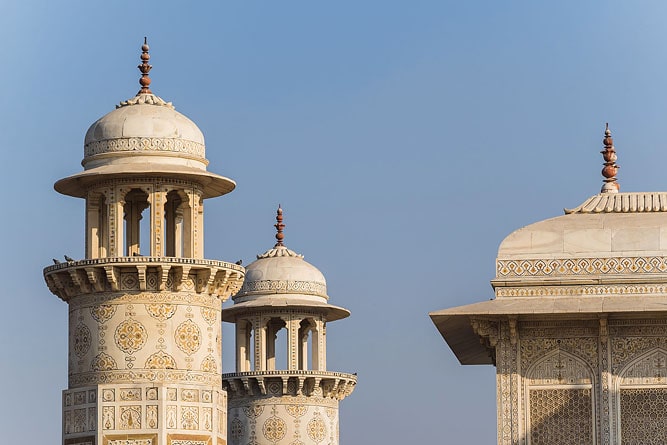Itimad-ud-Daulah (Baby Taj)
Historic building in Agra
could-see attraction
Opening hours: dawn-dusk
Address: Moti Bagh, Agra
Ticket price: Indian/foreigner ₹30/310, video ₹25
Visit duration: People typically spend up to 45 min here
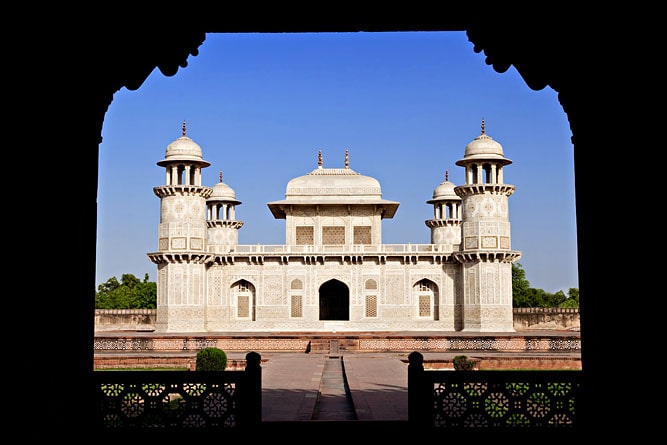
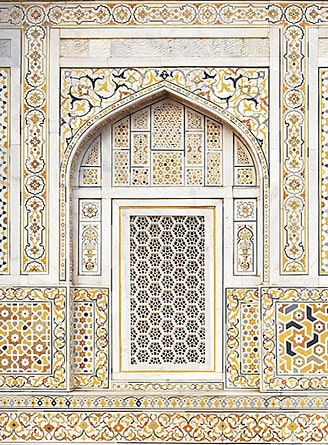
About Itimad-ud-Daulah (Baby Taj), Agra
The domeless architecture of the Itimad-Ud-Daulah marks its uniqueness among other Mughal architecture in India. The tomb is situated on the right bank of the river Yamuna.
Often recognised as the ‘Baby Taj or ‘Bachcha Taj’, this mausoleum was constructed between 1622 and 1628. The tomb marks the transition of themes from red sandstones to white marble stones in the architectural field.
Itimad-Ud-Daulah envelops the tomb of Mirza Ghiyas Beg and his wife Asmat Begum.
History of Itimad-Ud-Daulah
Mirza Ghiyas Beg was the father of the chief empress of Jahangir, Nur Jahan. He was also the grandfather of Mumtaz Mahal, wife of Shah Jahan. He was a Persian Amir in exile who arrived in India from Iran and provided his service to Akbar. He became Vazir, prime minister after his daughter was married to Jahangir, the Mughal emperor preceding Shah Jahan. He was a military general that held all 7000 mansab or ranks. He was entitled Itimad-Ud-Daulah which meant pillar of the state.
Within a few months of his wife's death, Mirza Ghiyas Beg perished in Agra in 1622. The empress Nur Jahan wanted to build a monument in the memory of her parents so she built the tomb, Itimad-Ud-Daulah.
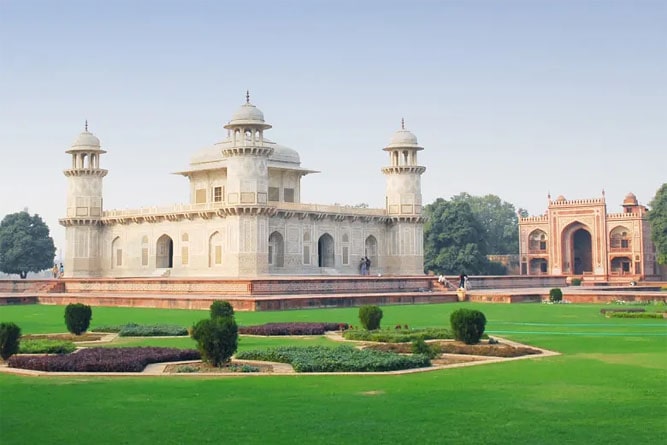
Architecture of Itimad-Ud-Daulah
The geography of the site preserves the symmetrical theme of the structure through its cruciform shape. The mausoleum is symmetrically placed in the centre of the garden. The garden is divided into four parts by artificial shallow rivers and pavilions that lead in four geometrical directions- east, west, north and south.
The gateways of the north and the south are imitations to contribute to maintaining the symmetrical design. There is a waterfront at the western gate while the eastern gateway is used for entrance. The four gardens are also squared-shaped and each garden has a fountain encompassed by rectangular pools. The gardens mirror the four seas of the world mentioned in the Quran.
The adjacent point of the four water channels disappears in the square-shaped stone that forms the base of the mausoleum. It is made of red sandstone. The tomb is compressed on the plinth. The tomb has four towers attached to the building. The minarets are octagonal in shape. The top resembles the structure of chhatris. The top of the tomb is square in shape blending the design of baradari that allows free flow of air inside the tomb. The roof is crowned with lotus petals and Kalash finials.
Inside the tomb, there are nine chambers that divide the space of the tomb equally. The central chamber is reachable from the southern side. It is the largest and the most significant chamber as it has the tombs of Mirza Ghiyas Beg and his wife Asmat Begum. The insides of the walls are filled with floral paintings of cypress trees. The patterns on the walls are influenced by Persian architecture. The Gujarat latticework of jali enlightens the interior of the tomb.
The only asymmetrical complex of the architecture is the cenotaphs of Nur Jahan's father and mother. The coffins are placed side by side. The stone tombs are decorated with inscriptions.
The interior side of the walls of the tomb have paintings, stucco and carvings implemented blending the Islamic design with Indian patterns. The artworks consist of minute animal and human figures. With the technique of the pietra dura style, semi-precious stones like onyx, cornelian, jasper and lapis lazuli are inlaid on the walls of the tomb which enhances the elegance of the monument.
The regal and majestic beauty of Indo-Islamic architecture can be witnessed inside the mausoleum. Itimad-Ud-Daulah is maintained by the Archeological Survey of India.
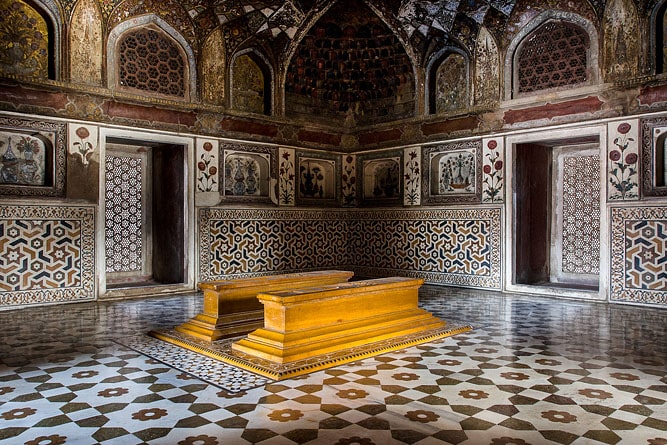
Entry fee and timings
The entry fees for Indians are ₹30 and for foreign tourists are ₹310. The mausoleum is open every day from dawn to dusk. There is a charge of ₹25 for video camera.
Facts and tips about Itimad-ud-Daulah (Baby Taj)
- Itimad-Ud-Daulah is the first mausoleum that was built on the banks of the Yamuna river, previously it was occupied by a sequence of aesthetic gardens.
- This mausoleum was the first architecture that was built of white marble stones.
- The eastern gate is only available for the entrance to the mausoleum. Entry tickets are available at the eastern gate itself.
- The entry tickets are rechecked at the time of departure, so keep your tickets with you until you leave the site.
How to reach Itimad-ud-Daulah (Baby Taj)
Itimad-ud-Daulah is located on the eastern bank of the Yamuna River, 5 minutes from Agra Fort and 10 minutes from the Taj Mahal by car. Akbar's Tomb is a 15-minute drive away.
See location on Google Maps
Other attractions near Itimad-ud-Daulah (Baby Taj)
- Agra Fort - 2.8 km
- Taj Mahal - 5.8 km
- Akbar's Tomb (Sikandra) - 11 km
FAQs about Itimad-ud-Daulah (Baby Taj)
1. Why is Itimad-Ud-Daulah called the ‘Baby Taj’?
Itimad-Ud-Daulah was the inspiration behind the construction of the Taj Mahal. The architecture of both monuments is similar in design and layout but Itimad-Ud-Daulah is smaller in proportion compared to the Taj Mahal.
2. Why is Itimad-Ud-Daulah famous?
The tomb is famous for its marble jali architecture along with its other distinctive and attractive features.
3. What is the other name of Nur Jahan?
Mehr-un-Nissa was the name of Nur Jahan before her marriage.
4. Are the other tombs located in Itimad-Ud-Daulah the graves of Nur Jahan's relatives like her daughter and her brother?
No, the graves of the empress's daughter and brother could be located in Lahore.
